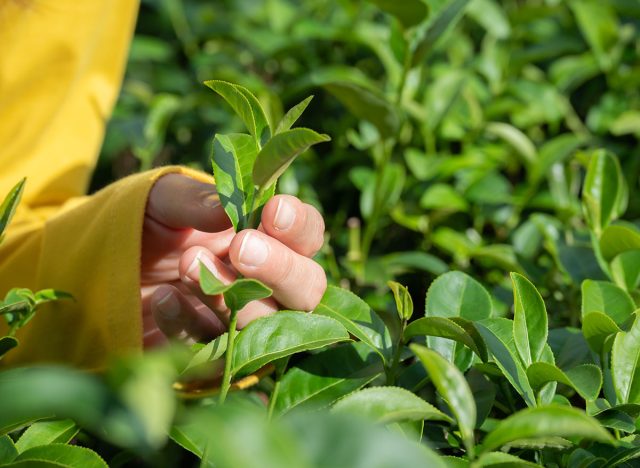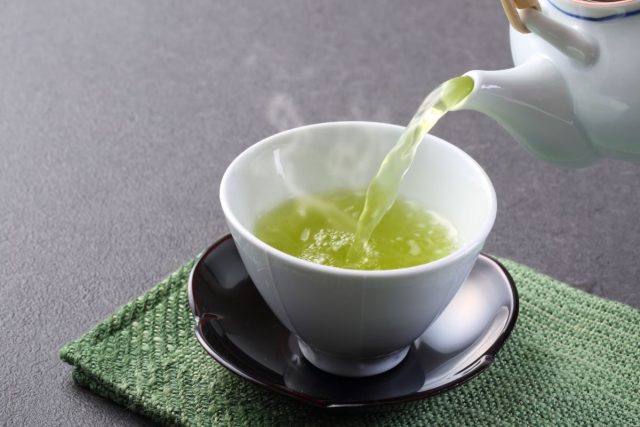Is Green Tea Healthier Than Black Tea? Here's What Science Says

Tea is the world's second most popular beverage after water, with around 80% of American households keeping it on hand, according to the U.S. Census Bureau. While black tea is the most consumed, accounting for approximately 84% of all tea consumed in the U.S., green tea is next in line, making up roughly 15%. With such a big gap in consumption, you might wonder: is one of these teas actually healthier than the other?
We're here to break it down and explore the science behind the benefits of black tea versus green tea.
Background and Origins: What's the Difference?

Fun fact, both black and green tea come from the Camellia sinensis plant, but vary in their processing methods. For instance, once a tea leaf is harvested, they undergo wilting and oxidation, which creates a distinct aroma and color to the tea. However, the oxidation process can be stopped with heat, essentially inactivating the enzymes. This is how different teas, such as black and green, are produced.
Let's explore these differences closer.
What is Black Tea?

Black tea is made from leaves of the Camellia sinensis plant, which are fully oxidized and fermented to develop the tea's distinct, robust flavor. During oxidation, the leaves are exposed to air, which deepens their color and intensifies the taste. From there, the leaves can be left as is, or heated, dried, and crushed to make black tea. This process results in a dark-colored tea with a strong, sometimes bitter flavor profile.
The most popular types of pure black tea include Assam tea and Darjeeling tea, while other popular blended black tea varieties include Earl Grey, Bigelow, and Chai teas.
What Is Green Tea?

Green tea is also made from the leaves of the Camellia sinensis plant, but it uses young, unfermented leaves. Unlike black tea, the leaves are quickly treated with heat, processed, and grated, without undergoing oxidation. Interestingly, pan frying is necessary for green tea leaves to prevent oxidation from occurring caused by the natural enzymes present in the leaves.
Sencha is the most popular type of green tea, which other green tea varieties are actually produced from, such as Matcha, Bancha, Gyokuro. Depending on the type of green consumed, the flavor profile may be a bit different. However, in comparison to the black tea, it's much more mild in flavor.
Keep in mind that the water temperature, steeping time, and tea concentration may also change the flavor profile of both green and black tea.
Nutritional Differences: How Do They Compare?

Black and green tea have fairly similar nutrient profiles, as both contain caffeine, antioxidants, and other important phytonutrients. A typical tea beverage, prepared in a proportion of 1 gram of tea leaf to 100 milliliters of water brewed for three minutes, contains approximately 250 to 350 milligrams of tea solids. These tea solids consist of roughly 30-42% catechins, or polyphenols, the good for you phytonutrients that function to keep your body at its prime, and 3-6% caffeine.
The Impact of Processing and Oxidation
The primary nutritional differences between black and green tea come from the ways they are processed and oxidized.
While both black and green tea contain similar amounts of polyphenols, the types of flavonoids, or phytonutrients, in each tea are slightly different as a result of this. Because of the unique processing methods, each offers some unique health benefits, which we'll explore further in the next section.
Calorie Content and Caffeine Levels
Both black and green tea are virtually calorie-free and contain comparable amounts of caffeine.
A 1-cup serving of black tea has zero calories with just a small amount of naturally occurring sodium (less than 5 milligrams) and contains 26 milligrams of caffeine.
In comparison, the same cup of green tea contains less than 2 calories, a small amount of protein (0.25 grams), and slightly more caffeine at 29 milligrams. It also contains trace amounts of vitamins and minerals, including iron, magnesium, potassium, sodium, zinc, manganese, thiamin, riboflavin, niacin, and vitamin B-6.
Nutrient Differences: Do They Matter?
While green tea has a few more vitamins and minerals than black tea, it's in relatively small portions. While I do agree every bit counts when it comes to nutrition, the bottom line really comes down to what you prefer and what you will actually consume. Remember, when actions become habits we can really see the impact medicinal foods, like tea, offer.
Health Benefits of Black Tea vs. Green Tea

Decades of research have demonstrated that the phytonutrients in both black and green tea can support cardiovascular and metabolic health. More recent studies suggest these teas may also offer potential benefits for anti-aging, anti-diabetic, and anti-cancer treatments. The primary benefits can be credited to catechins and theaflavins, which are potent phytonutrients found in both types of tea.
With that said, the processing methods used for black and green tea result in slightly different antioxidant profiles. Black tea is oxidized and fermented, during which the catechins are oxidized (or condensed) into compounds known as theaflavins and thearubigins. These compounds impart that dark color and bitter flavor to the black tea.
In contrast, green tea is not oxidized or fermented, which helps maintain a higher percentage of catechins, namely ECGC, or epigallocatechin-3-gallate. This is the key player you'll find throughout the research when green tea is highlighted for its benefits. Keep in mind, this doesn't mean the polyphenol content of green tea is higher or better than black tea, just different.
Unique Black Tea Benefits

Given the fact that black tea is generally more consumed than its green tea counterpart, it's important to shed light on the unique health benefits this brew offers too.
Black Tea and Weight Management
A 2016 study published in Molecules suggested that black tea polyphenols could be more effective than green tea polyphenols for promoting weight loss. However, most of this research was conducted using animal models, meaning we can't fully extrapolate the benefits to humans. This doesn't mean though that sipping on a cup of black tea (if that's your preference) won't help your weight loss goals, especially considering it's naturally calorie free and unsweetened.
Anti-Inflammatory and Diabetes Support
A 2019 review published in the International Journal of Health Sciences gave a more expansive look into the beneficial effects black tea offers, noting their anti-inflammatory properties and support for diabetes management. Although green tea also has anti-inflammatory effects, black tea contains higher levels of theaflavins, which may offer even stronger antioxidant protection. These theaflavins help neutralize free radicals in the body, potentially reducing inflammation and promoting heart health.
Unique Green Tea Benefits

While green tea shares anti-inflammatory properties with black tea, its standout benefit in recent years seems to be the role it plays in anticancer therapies.
Green Tea and Cancer Prevention
A 2020 study published in the International Journal of Molecular Sciences explored why green tea's catechins—primarily epigallocatechin, epicatechin gallate, and epigallocatechin gallate (EGCG)—contribute so prominently in cancer prevention.
Researchers found these compounds work together to neutralize free nitrogen and oxygen radicals, reducing inflammation and inducing cancer cell death while not affecting healthy cells. The effects green tea polyphenols have on stopping the growth of cancer cells and reducing the risk of cancer are found in the field of prostate, pancreatic, breast and stomach cancers. While green tea cannot replace pharmacological treatments like chemotherapy, incorporating it as an adjunct therapy may support the concept of "food as medicine" in disease prevention and treatment.
Black Tea vs. Green Tea: Is One Is Healthier?

There isn't a clear winner—and no, we're not trying to be difficult! While it may appear green tea makes the headlines more concerning its health benefits, decades of research have demonstrated that black tea provides significant advantages.
The most important thing to note is that both teas offer benefits and can easily fit in a balanced, healthy diet. At the end of the day, the tea you enjoy and are more likely to drink regularly is the one you should be consuming for optimum health. Consider the health promoting properties both tea varieties offer as your motivation when making your brew of choice, be it black or green, a regular part of your routine.
Why Trust Eat This, Not That!?
Eat This, Not That! is committed to creating high-quality content that you can trust to be accurate, properly researched, routinely reviewed, and updated with the latest information. Our writers, editors, and medical and/or certified experts consider this to be an unwavering promise we make to our readers in the pursuit of delivering impactful and meaningful content.
- Source: https://www.loc.gov/rr//scitech/SciRefGuides/teahealth.html#:~:text=Black%20tea%20is%20produced%20when,an%20intermediate%20kind%20of%20tea.
- Source: https://www.loc.gov/rr//scitech/SciRefGuides/teahealth.html#:~:text=Black%20tea%20is%20produced%20when,an%20intermediate%20kind%20of%20tea.
- Source: https://www.ncbi.nlm.nih.gov/pmc/articles/PMC6512146/
- Source: https://www.ncbi.nlm.nih.gov/pmc/articles/PMC4055352/
- Source: https://www.ncbi.nlm.nih.gov/pmc/articles/PMC7084675/
- Source: https://www.ncbi.nlm.nih.gov/pmc/articles/PMC4055352/
- Source: https://www.ncbi.nlm.nih.gov/pmc/articles/PMC3220617/
- Source: https://www.ncbi.nlm.nih.gov/pmc/articles/PMC4055352/
- Source: https://fdc.nal.usda.gov/fdc-app.html#/food-details/174144/nutrients
- Source: https://fdc.nal.usda.gov/fdc-app.html#/food-details/171917/nutrients
- Source: https://www.ncbi.nlm.nih.gov/pmc/articles/PMC4055352/
- Source: https://pubmed.ncbi.nlm.nih.gov/27941615/
- Source: https://www.ncbi.nlm.nih.gov/pmc/articles/PMC6512146/
- Source: https://www.ncbi.nlm.nih.gov/pmc/articles/PMC7084675/
- Source: https://www.ncbi.nlm.nih.gov/pmc/articles/PMC7084675/









